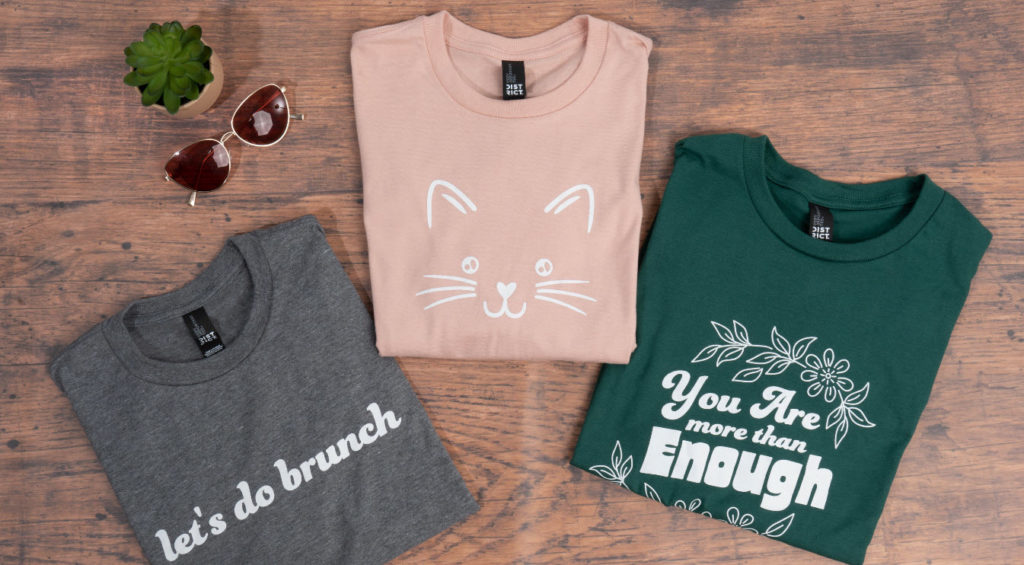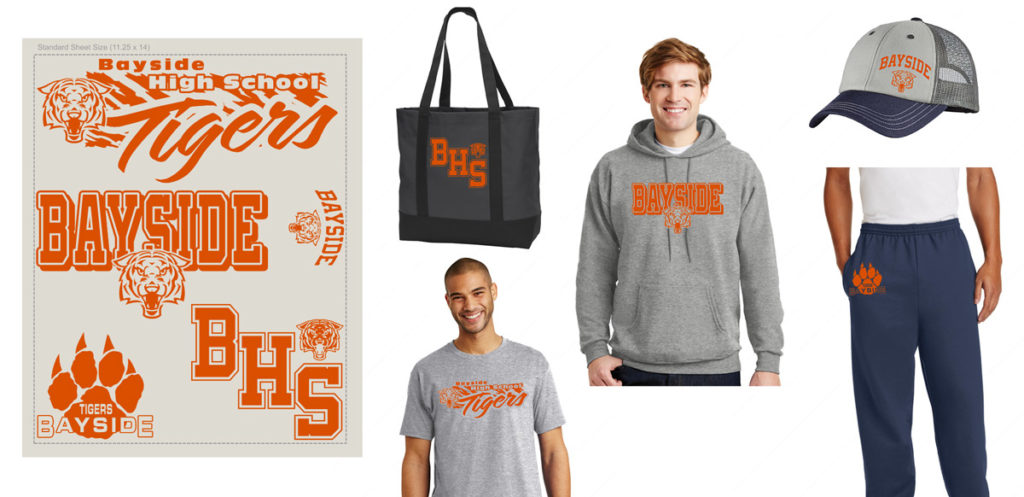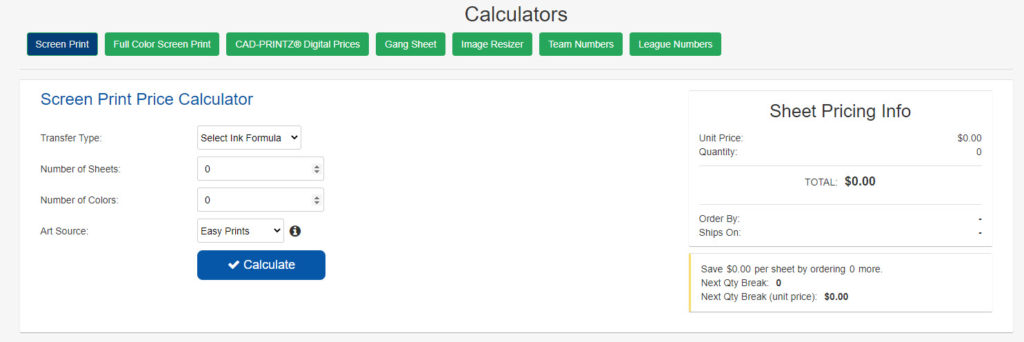Pricing Printed T-Shirts – How Much to Charge
Pricing printed t-shirts is not an easy thing to do for your t-shirt business, but we do have some pricing strategies and tips for you to follow as a guide to help you determine how much to mark up a shirt.
One of the top questions we see is how much should you charge for your t-shirts or how much do custom t-shirts sell for.
How to price your t-shirts depends on many factors – where you are selling, your costs, how much you want to make, and what you are selling, to name a few.
We want to help you find the perfect t-shirt markup that’s right for your t-shirt business.
The selling price for t-shirts is important because if you price too high, you risk not selling enough shirts. It’s hard to let a customer walk away saying your price is too high.
But if you price too low, you won’t be making enough profit. You’ll be working hard but spinning your wheels.
Let’s find that sweet spot that keeps your customer ordering and you in business.
So let’s break down some of the components that will affect your t-shirt selling prices.
Your T-Shirt Production Cost
Your costs are a big aspect that determine your selling prices. You need to know your costs before you set the selling price.
Some people try to do the opposite. They try to set the selling price first. But without even knowing the costs, this is a bad idea.
So let’s break down some of the t-shirt production costs. Some of these you may not have even been thinking about.
In a cost-based pricing strategy, you take your direct labor and material costs and add in your overhead to get your total costs.

Your direct labor cost includes the labor it takes to print your shirts. This is especially important if you have hired employees printing shirts. How much are you paying someone per hour?
Even if you aren’t paying someone else, how much do you want to pay yourself for your labor? Don’t sell yourself short. You’re an entrepreneur – how much do you want to make in your t-shirt business? You’re probably not doing this to provide a free service.
In this example, we’ll use $15 per hour as the wage. If it takes about a minute to load your shirt, pre-press it, press the transfer on, and remove the shirt from the heat press, you can print about 60 shirts an hour.
Your direct labor cost per shirt then, is $0.25 each.
You material costs include anything that you are using to produce your shirt. In this case, it will be your blank shirt and transfer.
If you had to pay for shipping to get any of your materials, don’t forget to include that price when you are calculating this out.
The next part of the equation is your overhead costs. So many shops forget to take this into consideration when determining what is a good markup price for a shirt.
They think they are making money on each order because they are charging more than the direct costs of the materials. But then, at the end of the month, after they’ve paid other bills such as rent, utilities, and other overhead costs, they’ve barely made any profit, if any at all.

So a good rule of thumb, and one that works for most companies, is to charge 15% overhead.
[Related Content: How to Reduce Your Transfer Costs]
Your T-Shirt Brand Quality
Another consideration of your custom t-shirt pricing is the quality of the shirts you are selling, and the quality you are portraying to your customers.
If you are using the cheapest t-shirt you can get, you don’t want to charge a premium price for the finished shirt.
On the other hand, if your brand uses premium apparel and that’s what your customer is expecting, then don’t under charge for it either. If you are selling a premium product, you won’t be wanting to compete on price with the bargain printer down the street.

So take your brand’s perception into your pricing strategy. At the end of the day, your price will communicate what your product is worth and what your customers perceive them to be worth.
[Related Content: T-Shirt Marketing 101: Product]
Pricing Printed T-Shirts: Wholesale Pricing vs Retail Pricing
One of the last pieces to pricing printed t-shirts is where you’re selling and who you’re selling to.
- Are you selling shirts online or out of a storefront?
- Are you selling to groups or individuals?
Selling your shirts online or in your local storefront may affect your t-shirt selling price.
If you are selling online, there will be some major online t-shirt shops that you will need to compare your pricing with.
If you are selling locally, then you’ll need to know your local competition and the buying options that your customers have in your area.
You’ll also want to consider if you are selling wholesale or retail.
Wholesale would be if you are selling to a group. You have one buyer for many people. Examples of some wholesale customers would be a school, a sports team, a business, etc.
Retail would be if you are selling to each individual consumer, like you would buy in a store. An example of selling retail would be if you are selling t-shirts online in your Etsy shop.
[Related Content: 5 Retail Pricing Methods for Custom Apparel]
Your pricing will be very different for these two types of customers.
We’ll show you how to price for both of these.
T-Shirt Pricing Strategies
Now that you know some of the variables that will affect your t-shirt selling prices, here are two easy ways to set your pricing for printed t-shirts.
- Competitor Pricing Strategy
The first strategy is to research your competitors. This strategy is pretty popular.
Like we mentioned above, your competitors may be different depending on where you are selling.
Whether you are selling online or in your storefront, one t-shirt seller that most people are familiar with is Custom Ink.
Since Custom Ink has made it fairly easy to get custom shirts for groups no matter where you are, it’s a good idea to take a look at their pricing.

Once you see what Custom Ink is selling for the same quantity, similar shirt style, number of ink colors, and number of image placements, you’ll be able to get an idea of what you could sell your shirts for.
This is a good starting point, but remember to make sure you are covering your costs and making a profit.
- Cost Based Pricing Strategy
The second strategy for pricing printed t-shirts is your cost based pricing.
This is when you take your t-shirt production costs we talked about above, add them together and add in your desired profit margin.
Add your direct costs and labor + overhead = your total costs.
To get your wholesale selling price, multiply your costs x 2.
To price your t-shirts for retail, multiply your wholesale selling price x 2.

This strategy allows you to add in your desired profit margin for what you want to get paid and to sell your shirts for what the brand is worth.
Keep in mind, that this is where you can still get into some troubled waters. Your markup percentage may take some extensive research and trial and error to find that sweet spot.
Our example above is multiplying your costs by 2. This would be a 50% profit margin, or a 100% mark up. This is a good place to start, but you may need to adjust to fit your own strategy.
Make sure you also know the difference between markup percentage and profit margin percentage. These are two different things and are calculated differently.
To find your profit margin percentage, take your profit divided by the selling price, then multiply by 100 to get the percentage.
To find your markup percentage, take your selling price minus your cost, and divide that by the cost. Then multiply by 100 to get the percentage.
There are also online calculators that help you find your profit margin and markup.
[Related Content: Psychological Pricing for Your T-Shirt Business]
Increase Your Profit Margins
An easy way to increase your profit margin is to reduce your costs.
One of the advantages of printing t-shirts with a heat press and screen printed transfers is the gang sheet.
You can fit multiple images onto your transfer sheet for the same pricing. Therefore, you are reducing your printing cost because your individual image price will be less.

Your gang sheet is yours to fill as you are able. You have control to fit your images on the sheet using the free online design center, Easy View®.
There are also pricing calculators to help you figure out your costs.

Try the price calculator to see how much your next printing job will cost, so you will be better equipped when pricing printed t-shirts.
